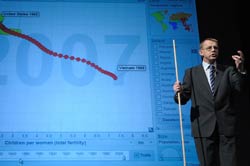Global health data guru Hans Rosling urges researchers to be more inclusive
April 2010 | Volume 9, Issue 2

Photo by Ernie Branson
Dr. Hans Rosling of the Karolinska Institute
drew a standing-room only crowd at his talk
titled, "The New Health Gap: Science for
Emerging Economies vs. the Bottom Billion."
By Ann Cochran
Researchers should use their muscles and brains to solve global health problems and expand their study populations to include the world's poorest people, urged Dr. Hans Rosling of the Karolinska Institute at a recent lecture that drew a capacity crowd.
Rosling has a reputation as the man who proves statistics are not boring, and he did not disappoint. Known as the guru of global health data, Rosling told stories using charts populated with colorful bubbles representing countries. Bubbles scattered as Rosling showed changes in income, fertility and life expectancy over years, decades and centuries.
The February lecture titled "The New Health Gap: Science for Emerging Economies vs. the Bottom Billion," was sponsored by Fogarty as the final in a series of events that marked its 40th anniversary.
During his talk, Rosling took the audience through time to illustrate how the world has changed. A co-founder of Gapminder, a non-profit that promotes a fact-based world view, he used his own Trendalyzer software to convert numbers into interactive graphics.
"Global health is full of ignorance," he said, "full of myths. There's so much to sort out." We don't understand the speed and magnitude of progress in Asia. He sped through misconceptions about HIV, stating, "There is no such thing as an African HIV epidemic."
To best understand the world today, Rosling declared it can no longer be categorized as the developing world versus the Western world. It is more appropriate to use high-, middle- and low-income categories. One billion people are now considered as high-income, two billion are low and three billion are in the middle. Once developing countries are now emerging economies.
He told an anecdote about top medical students in Sweden in his current global health class. Discussing life expectancy, they believed smaller families have greater life expectancy. Rosling put 1950s data into his charts and with bubble placement showed the NIH audience that the students' hypothesis worked for 1950.

Photo by Ernie Branson
Dr. Rosling visited NIH as a Fogarty Scholar-
in-Residence, a special program to mark
the Center’s 40th anniversary. NIH Director
Dr. Francis Collins (right) helped Fogarty
Director Dr. Roger I. Glass (center) greet
Rosling before his lecture.
While he fast forwarded to 2007, Rosling recited a timeline of developments such as China's Great Leap Forward, family planning, vaccinations, and the HIV epidemic. Bubbles flew as global birth rates dropped, eventually landing in a very different pattern. Today, India has a 2.8 birth rate, Bangladesh 2.4 and Iran 1.85.
"Now take it out of the bedroom and into the bathroom and kitchen. If you have water, soap, and food on the table, you'll live 65 years," said Rosling. "Then we come in, our profession, and try to make it longer."
Populations used to first get rich, then healthy. Now, it's the other way around. He used his software to travel back to the 1800s when countries were bunched together in income and life expectancy, and advanced forward. For so long, from 1800-1950, the world was diverging. Now it's converging.
"If you want to understand global health, start with the money," said Rosling. He praised former President George W. Bush for funding the bank bailout with loans from Brazil, Russia and China. The emerging economies had money. Bush also convened the G-20, realizing the G-7 wasn't broad enough to stabilize global financial markets.
In addition to diagnostics and access to treatment, drugs play a major role in global health. Rosling applauded broadened international sponsoring of pharmaceuticals, a new realism about pricing in lower-income countries and branding of their own generics.
Rosling described former U.K. Prime Minister Tony Blair and rock star-activist Bono coming together with Bush to raise funding for AIDS, TB and malaria. People with other diseases often have to personally raise money for their care, or do without. Middle-income populations can get diagnosis and limited treatment, but they can't benefit from all the progress yet.
"I see two research components to global health," said Rosling at the end of his talk. He recommended solving the health problems of the poorest. "Make that new TB diagnostic test that can be used by primary health care providers in the village and you can die satisfied."
Second, he advised researchers "don't limit your exposure and your genetic variations to high-income populations. Do research on diabetes and Parkinson's across the world, where there is a variation, because it pays off."
More Information
To view Adobe PDF files,
download current, free accessible plug-ins from Adobe's website.